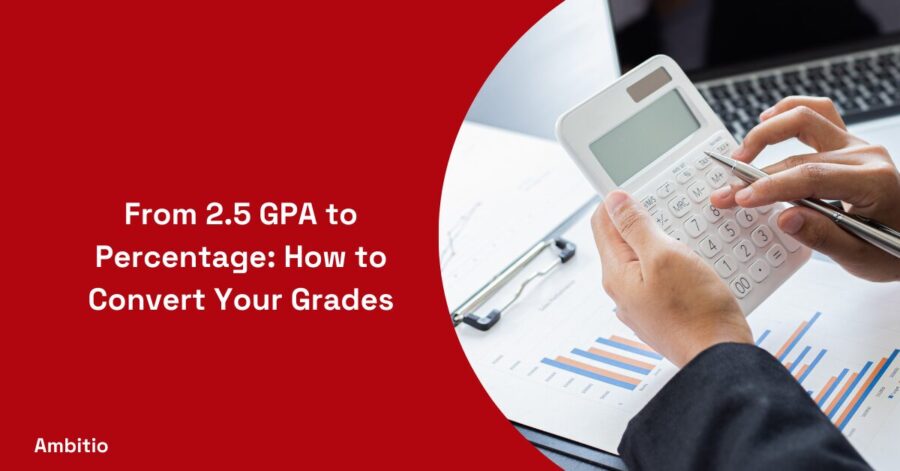14 December 2024
5 minutes read
From 2.5 GPA to Percentage: How to Convert Your Grades

If you’ve received a 2.5 GPA in college and want to understand how it translates to a percentage, you’re in the right place.
In this guide, we’ll delve into the GPA-to-percentage conversion process, explore the grading scale, and provide you with valuable insights on how to make sense of your academic performance.
Understanding GPA and Its Scale
GPA stands for Grade Point Average, and it’s a measure of your academic performance in college. It’s typically calculated on a scale of 0.0 to 4.0, with 4.0 being the highest achievable GPA.
Here’s a brief overview of the GPA scale:
- 4.0: A+
- 3.7-3.9: A
- 3.3-3.6: A-
- 3.0-3.2: B+
- 2.7-2.9: B
- 2.3-2.6: B-
- 2.0-2.2: C+
- 1.7-1.9: C
- 1.3-1.6: C-
- 1.0-1.2: D+
- 0.7-0.9: D
- 0.0-0.6: F
Converting 2.5 GPA to Percentage
To convert your GPA to a percentage, you need to know your college’s specific grading scale. The formula varies from institution to institution, but here’s a general guideline:
Percentage = (GPA / 4.0) * 100
So, for a 2.5 GPA:
Percentage = (2.5 / 4.0) * 100 = 62.5%
Your 2.5 GPA translates to a 62.5% on this scale.
How to Calculate Your GPA
Now that we’ve covered the basics, let’s dive deeper into how to calculate your GPA. Your GPA is a crucial measure of your academic performance, and it’s essential to understand how it’s calculated.
Understanding the GPA Calculation Formula
The GPA calculation formula is relatively straightforward. You add up all your grade points and divide by the number of credit hours or courses you’ve taken. Here’s the formula:
GPA = Total Grade Points / Total Credit Hours
Assigning Grade Points to Letter Grades
Each letter grade corresponds to a specific number of grade points. Here’s a common conversion:
- A+ or A: 4.0
- A-: 3.7
- B+: 3.3
- B: 3.0
- B-: 2.7
- C+: 2.3
- C: 2.0
- C-: 1.7
- D+: 1.3
- D: 1.0
- F: 0.0
Example GPA Calculation
Let’s say you’ve completed four courses with the following grades and credit hours:
- Course 1 (A, 3 credit hours)
- Course 2 (B+, 4 credit hours)
- Course 3 (C, 3 credit hours)
- Course 4 (A-, 2 credit hours)
To calculate your GPA, assign grade points to each grade, calculate the total grade points, and divide by the total credit hours:
- Course 1: 4.0 (A) * 3 (credit hours) = 12.0
- Course 2: 3.3 (B+) * 4 (credit hours) = 13.2
- Course 3: 2.0 (C) * 3 (credit hours) = 6.0
- Course 4: 3.7 (A-) * 2 (credit hours) = 7.4
Total Grade Points = 12.0 + 13.2 + 6.0 + 7.4 = 38.6
Total Credit Hours = 3 + 4 + 3 + 2 = 12
GPA = 38.6 / 12 = 3.22
So, in this example, your GPA is 3.22, which is slightly above a “B+” average.
GPA Conversion Scales
Different GPA Scales
It’s important to note that there are different GPA scales in use. We’ve previously discussed the 4.0 scale, which is common in the United States, but other countries and institutions may have their own scales. Let’s explore some of these scales.
5.0 GPA Scale
The 5.0 GPA scale is often used in high schools, particularly in honors and Advanced Placement (AP) courses. This scale includes additional grade point values for more challenging courses.
Here’s how the 5.0 scale typically works:
- A+ or A: 5.0
- A-: 4.7
- B+: 4.3
- B: 4.0
- B-: 3.7
- …
This scale allows for higher GPA values, reflecting the increased difficulty of honors and AP courses.
10.0 GPA Scale
In some educational systems, a 10.0 GPA scale is used, especially in European countries. This scale provides even more granularity in grading.
Here’s how the 10.0 scale typically works:
- A+: 10.0
- A: 9.0
- A-: 8.0
- B+: 7.0
- B: 6.0
This scale allows for precise differentiation between academic performance.
GPA Conversion Challenges
Challenges in GPA Conversion
Converting GPAs between different scales can be challenging, as various institutions may use distinct grading systems. This can be particularly problematic for students applying to colleges or universities abroad or transferring between institutions.
Grade Inflation and Deflation
Another challenge is the potential for grade inflation or deflation. Some schools may have more lenient grading standards, resulting in higher GPAs, while others may have stricter standards, leading to lower GPAs.
This can affect the perceived value of your GPA when applying to colleges or jobs.
Weighted vs. Unweighted GPAs
Many high schools offer both weighted and unweighted GPAs. Weighted GPAs give extra points for honors or AP courses, while unweighted GPAs treat all courses equally.
| Aspect | Unweighted GPA | Weighted GPA |
|---|---|---|
| Definition | Calculates grades based on their original values. | Assigns higher values to honors, AP, or IB courses. |
| Course Difficulty | Treats all courses equally. | Rewards students for taking more challenging courses. |
| Scale | Typically on a 4.0 scale. | Often on a 5.0 or 6.0 scale for weighted courses. |
| Impact on College Apps | Colleges may recalculate or consider both GPA types. | Can enhance chances of college admission, especially at competitive institutions. |
| High School Policy | The sum of all grade points divided by the total number of courses. | Typically reported alongside unweighted GPA. |
| Course Selection | Encourages students to take more rigorous courses. | This may deter students from taking challenging classes due to the potential impact on GPA. |
| Fairness | Can be seen as more fair for students in schools without honors or AP classes. | May favor students in schools with more advanced courses. |
| Extracurriculars | Puts more emphasis on activities outside of academics. | Can help offset the impact of a lower unweighted GPA. |
| GPA Calculation | Sum of all grade points divided by the total number of courses. | Weighted GPA adds extra points for advanced courses. |
| College Scholarships | May have a smaller impact on scholarship opportunities. | Can improve eligibility for merit-based scholarships. |
When converting these GPAs, it’s crucial to consider whether the scale accounts for weighted grades.
GPA Conversion Tools and Resources
Online GPA Calculators
To simplify the GPA to percentage conversion, numerous online calculators are available. These tools allow you to input your grades and credit hours, and they provide you with your GPA on a specific scale, along with the corresponding percentage.
College Admissions Offices
If you’re applying to colleges or universities, their admissions offices can provide guidance on GPA conversion. They are familiar with various grading systems and can assist you in understanding how your GPA aligns with their requirements.
Academic Advisors
If you’re a college student navigating GPA conversion for transfer purposes, consult your academic advisor. They can help you decipher your GPA in the context of your academic journey and assist with transfer applications.
Conclusion
Understanding how to calculate and convert your GPA is essential for interpreting your academic performance accurately. Whether you’re a high school student exploring college options or a college student considering a transfer, knowing how your GPA translates to different scales is valuable.
In this comprehensive guide, we’ve covered the fundamentals of GPA calculation, explored various GPA scales, discussed conversion challenges, and highlighted resources to aid in the process.
Remember that your GPA is a reflection of your hard work and dedication, and it’s always possible to improve and aim for higher academic achievements.
We hope this guide has provided you with the knowledge and tools you need to navigate the world of GPA conversion effectively. As you continue your educational journey, use this information to make informed decisions about your academic goals and aspirations.
FAQs
Q1: What does a 2.5 GPA mean?
A 2.5 GPA is equivalent to a “C+” on the GPA scale. It represents an average academic performance.
Q2: Can I get into college with a 2.5 GPA?
While admission requirements vary, many colleges accept students with a 2.5 GPA. However, it’s essential to research and consider different schools based on your GPA.
Q3: Is the GPA to percentage conversion the same in all colleges?
No, the conversion may vary from college to college. It’s crucial to check your specific institution’s grading scale for accuracy.
Q4: Can I improve my GPA?
Yes, you can improve your GPA by working hard and getting better grades in your courses. It’s never too late to strive for academic excellence.
Q5: What is the national average GPA for college students?
The national average GPA for college students in the United States is around 3.0, which is a “B” grade.

You can study at top universities worldwide!
Get expert tips and tricks to get into top universities with a free expert session.
Book Your Free 30-Minute Session Now! Book a call now




























